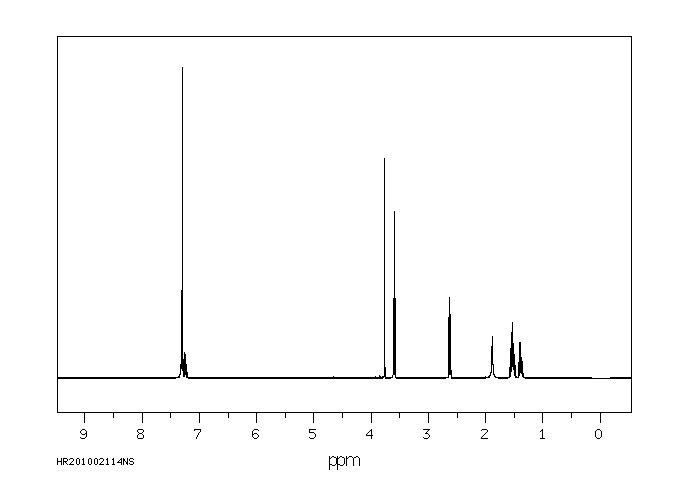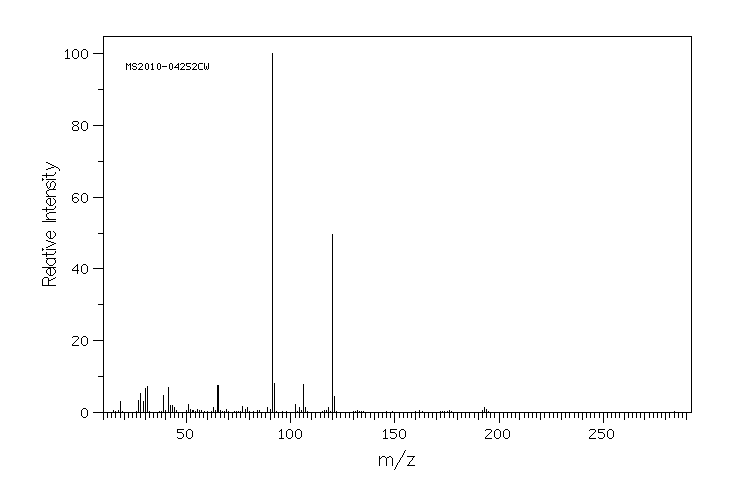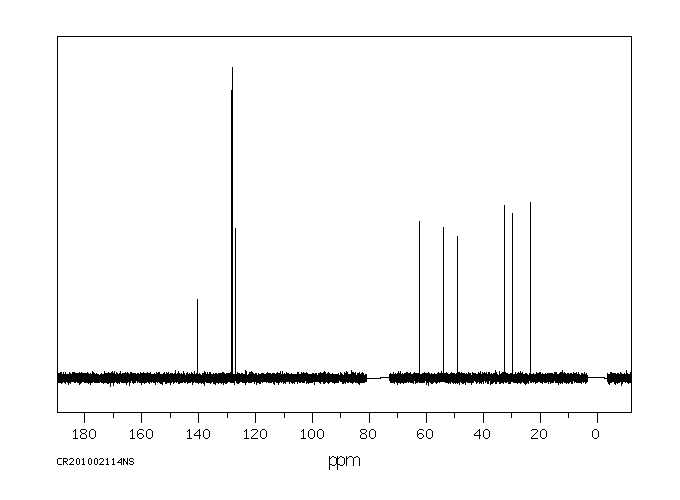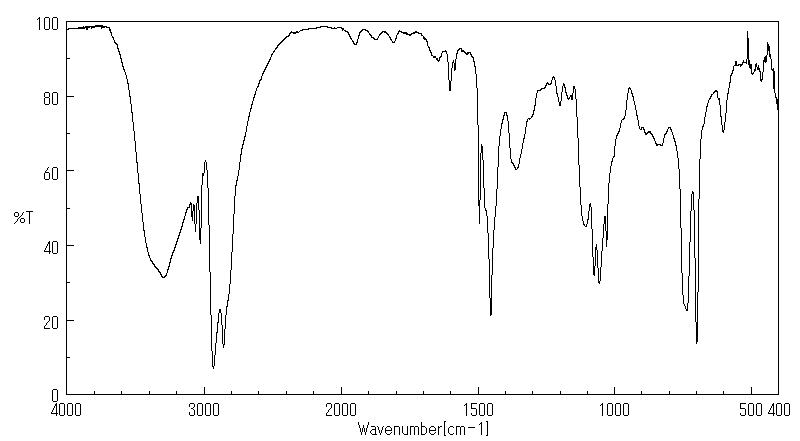N-(5-羟基戊基)苄胺 | 2937-99-7
中文名称
N-(5-羟基戊基)苄胺
中文别名
5-苄胺基-1-戊醇
英文名称
N-benzyl-5-aminopentan-1-ol
英文别名
5-(benzylamino)pentan-1-ol;5-benzylamino-1-pentanol;N-5-hydroxypentyl-N-benzylamine
CAS
2937-99-7
化学式
C12H19NO
mdl
——
分子量
193.289
InChiKey
YMNRQBMCCMQGSH-UHFFFAOYSA-N
BEILSTEIN
——
EINECS
——
-
物化性质
-
计算性质
-
ADMET
-
安全信息
-
SDS
-
制备方法与用途
-
上下游信息
-
文献信息
-
表征谱图
-
同类化合物
-
相关功能分类
-
相关结构分类
物化性质
-
沸点:168°C/6mmHg(lit.)
计算性质
-
辛醇/水分配系数(LogP):1.7
-
重原子数:14
-
可旋转键数:7
-
环数:1.0
-
sp3杂化的碳原子比例:0.5
-
拓扑面积:32.3
-
氢给体数:2
-
氢受体数:2
SDS
5-苄胺基-1-戊醇
模块 1. 化学品
产品名称: 5-Benzylamino-1-peNTanol
模块 2. 危险性概述
GHS分类
物理性危害 未分类
健康危害
皮肤腐蚀/刺激 第2级
严重损伤/刺激眼睛 2A类
环境危害 未分类
GHS标签元素
图标或危害标志
信号词 警告
危险描述 造成皮肤刺激
造成严重眼刺激
防范说明
[预防] 处理后要彻底清洗双手。
穿戴防护手套/护目镜/防护面具。
[急救措施] 眼睛接触:用水小心清洗几分钟。如果方便,易操作,摘除隐形眼镜。继续冲洗。
眼睛接触:求医/就诊
皮肤接触:用大量肥皂和水轻轻洗。
若皮肤刺激:求医/就诊。
脱掉被污染的衣物,清洗后方可重新使用。
模块 3. 成分/组成信息
单一物质/混和物 单一物质
化学名(中文名): 5-苄胺基-1-戊醇
百分比: >98.0%(T)
CAS编码: 2937-99-7
俗名: N-(5-Hydroxyamyl)benzylamine , N-(5-HydroxypeNTyl)benzylamine
5-苄胺基-1-戊醇
模块 3. 成分/组成信息
分子式: C12H19NO
模块 4. 急救措施
吸入: 将受害者移到新鲜空气处,保持呼吸通畅,休息。若感不适请求医/就诊。
皮肤接触: 立即去除/脱掉所有被污染的衣物。用大量肥皂和水轻轻洗。
若皮肤刺激或发生皮疹:求医/就诊。
眼睛接触: 用水小心清洗几分钟。如果方便,易操作,摘除隐形眼镜。继续清洗。
如果眼睛刺激:求医/就诊。
食入: 若感不适,求医/就诊。漱口。
紧急救助者的防护: 救援者需要穿戴个人防护用品,比如橡胶手套和气密性护目镜。
模块 5. 消防措施
合适的灭火剂: 干粉,泡沫,雾状水,二氧化碳
不适用的灭火剂: 棒状水
特殊危险性: 小心,燃烧或高温下可能分解产生毒烟。
特定方法: 从上风处灭火,根据周围环境选择合适的灭火方法。
非相关人员应该撤离至安全地方。
周围一旦着火:如果安全,移去可移动容器。
消防员的特殊防护用具: 灭火时,一定要穿戴个人防护用品。
模块 6. 泄漏应急处理
个人防护措施,防护用具, 使用个人防护用品。远离溢出物/泄露处并处在上风处。确保足够通风。
紧急措施: 泄露区应该用安全带等圈起来,控制非相关人员进入。
环保措施: 防止进入下水道。
控制和清洗的方法和材料: 用合适的吸收剂(如:旧布,干砂,土,锯屑)吸收泄漏物。一旦大量泄漏,筑堤控
制。附着物或收集物应该立即根据合适的法律法规废弃处置。
模块 7. 操作处置与储存
处理
技术措施: 在通风良好处进行处理。穿戴合适的防护用具。防止烟雾产生。处理后彻底清洗双手
和脸。
注意事项: 如果蒸气或浮质产生,使用通风、局部排气。
操作处置注意事项: 避免接触皮肤、眼睛和衣物。
贮存
储存条件: 保持容器密闭。存放于凉爽、阴暗处。
存放于惰性气体环境中。
远离不相容的材料比如氧化剂存放。
气敏
包装材料: 依据法律。
模块 8. 接触控制和个体防护
工程控制: 尽可能安装封闭体系或局部排风系统,操作人员切勿直接接触。同时安装淋浴器和洗
眼器。
个人防护用品
呼吸系统防护: 防毒面具。依据当地和政府法规。
手部防护: 防护手套。
眼睛防护: 安全防护镜。如果情况需要,佩戴面具。
皮肤和身体防护: 防护服。如果情况需要,穿戴防护靴。
5-苄胺基-1-戊醇
模块 9. 理化特性
液体
外形(20°C):
外观: 透明
颜色: 无色-浅黄色
气味: 无资料
pH: 无数据资料
熔点: 无资料
沸点/沸程 168 °C/0.8kPa
闪点: 无资料
爆炸特性
爆炸下限: 无资料
爆炸上限: 无资料
密度: 1.01
溶解度:
[水] 无资料
[其他溶剂] 无资料
模块 10. 稳定性和反应性
化学稳定性: 一般情况下稳定。
危险反应的可能性: 未报道特殊反应性。
须避免接触的物质 氧化剂
危险的分解产物: 一氧化碳, 二氧化碳, 氮氧化物 (NOx)
模块 11. 毒理学信息
急性毒性: 无资料
对皮肤腐蚀或刺激: 无资料
对眼睛严重损害或刺激: 无资料
生殖细胞变异原性: 无资料
致癌性:
IARC = 无资料
NTP = 无资料
生殖毒性: 无资料
模块 12. 生态学信息
生态毒性:
鱼类: 无资料
甲壳类: 无资料
藻类: 无资料
残留性 / 降解性: 无资料
潜在生物累积 (BCF): 无资料
土壤中移动性
log水分配系数: 无资料
土壤吸收系数 (Koc): 无资料
亨利定律 无资料
constaNT(PaM3/mol):
模块 13. 废弃处置
如果可能,回收处理。请咨询当地管理部门。建议在装有后燃和洗涤装置的化学焚烧炉中焚烧。废弃处置时请遵守
国家、地区和当地的所有法规。
5-苄胺基-1-戊醇
模块 14. 运输信息
联合国分类: 与联合国分类标准不一致
UN编号: 未列明
模块 15. 法规信息
《危险化学品安全管理条例》(2002年1月26日国务院发布,2011年2月16日修订): 针对危险化学品的安全使用、
生产、储存、运输、装卸等方面均作了相应的规定。
模块16 - 其他信息
N/A
模块 1. 化学品
产品名称: 5-Benzylamino-1-peNTanol
模块 2. 危险性概述
GHS分类
物理性危害 未分类
健康危害
皮肤腐蚀/刺激 第2级
严重损伤/刺激眼睛 2A类
环境危害 未分类
GHS标签元素
图标或危害标志
信号词 警告
危险描述 造成皮肤刺激
造成严重眼刺激
防范说明
[预防] 处理后要彻底清洗双手。
穿戴防护手套/护目镜/防护面具。
[急救措施] 眼睛接触:用水小心清洗几分钟。如果方便,易操作,摘除隐形眼镜。继续冲洗。
眼睛接触:求医/就诊
皮肤接触:用大量肥皂和水轻轻洗。
若皮肤刺激:求医/就诊。
脱掉被污染的衣物,清洗后方可重新使用。
模块 3. 成分/组成信息
单一物质/混和物 单一物质
化学名(中文名): 5-苄胺基-1-戊醇
百分比: >98.0%(T)
CAS编码: 2937-99-7
俗名: N-(5-Hydroxyamyl)benzylamine , N-(5-HydroxypeNTyl)benzylamine
5-苄胺基-1-戊醇
模块 3. 成分/组成信息
分子式: C12H19NO
模块 4. 急救措施
吸入: 将受害者移到新鲜空气处,保持呼吸通畅,休息。若感不适请求医/就诊。
皮肤接触: 立即去除/脱掉所有被污染的衣物。用大量肥皂和水轻轻洗。
若皮肤刺激或发生皮疹:求医/就诊。
眼睛接触: 用水小心清洗几分钟。如果方便,易操作,摘除隐形眼镜。继续清洗。
如果眼睛刺激:求医/就诊。
食入: 若感不适,求医/就诊。漱口。
紧急救助者的防护: 救援者需要穿戴个人防护用品,比如橡胶手套和气密性护目镜。
模块 5. 消防措施
合适的灭火剂: 干粉,泡沫,雾状水,二氧化碳
不适用的灭火剂: 棒状水
特殊危险性: 小心,燃烧或高温下可能分解产生毒烟。
特定方法: 从上风处灭火,根据周围环境选择合适的灭火方法。
非相关人员应该撤离至安全地方。
周围一旦着火:如果安全,移去可移动容器。
消防员的特殊防护用具: 灭火时,一定要穿戴个人防护用品。
模块 6. 泄漏应急处理
个人防护措施,防护用具, 使用个人防护用品。远离溢出物/泄露处并处在上风处。确保足够通风。
紧急措施: 泄露区应该用安全带等圈起来,控制非相关人员进入。
环保措施: 防止进入下水道。
控制和清洗的方法和材料: 用合适的吸收剂(如:旧布,干砂,土,锯屑)吸收泄漏物。一旦大量泄漏,筑堤控
制。附着物或收集物应该立即根据合适的法律法规废弃处置。
模块 7. 操作处置与储存
处理
技术措施: 在通风良好处进行处理。穿戴合适的防护用具。防止烟雾产生。处理后彻底清洗双手
和脸。
注意事项: 如果蒸气或浮质产生,使用通风、局部排气。
操作处置注意事项: 避免接触皮肤、眼睛和衣物。
贮存
储存条件: 保持容器密闭。存放于凉爽、阴暗处。
存放于惰性气体环境中。
远离不相容的材料比如氧化剂存放。
气敏
包装材料: 依据法律。
模块 8. 接触控制和个体防护
工程控制: 尽可能安装封闭体系或局部排风系统,操作人员切勿直接接触。同时安装淋浴器和洗
眼器。
个人防护用品
呼吸系统防护: 防毒面具。依据当地和政府法规。
手部防护: 防护手套。
眼睛防护: 安全防护镜。如果情况需要,佩戴面具。
皮肤和身体防护: 防护服。如果情况需要,穿戴防护靴。
5-苄胺基-1-戊醇
模块 9. 理化特性
液体
外形(20°C):
外观: 透明
颜色: 无色-浅黄色
气味: 无资料
pH: 无数据资料
熔点: 无资料
沸点/沸程 168 °C/0.8kPa
闪点: 无资料
爆炸特性
爆炸下限: 无资料
爆炸上限: 无资料
密度: 1.01
溶解度:
[水] 无资料
[其他溶剂] 无资料
模块 10. 稳定性和反应性
化学稳定性: 一般情况下稳定。
危险反应的可能性: 未报道特殊反应性。
须避免接触的物质 氧化剂
危险的分解产物: 一氧化碳, 二氧化碳, 氮氧化物 (NOx)
模块 11. 毒理学信息
急性毒性: 无资料
对皮肤腐蚀或刺激: 无资料
对眼睛严重损害或刺激: 无资料
生殖细胞变异原性: 无资料
致癌性:
IARC = 无资料
NTP = 无资料
生殖毒性: 无资料
模块 12. 生态学信息
生态毒性:
鱼类: 无资料
甲壳类: 无资料
藻类: 无资料
残留性 / 降解性: 无资料
潜在生物累积 (BCF): 无资料
土壤中移动性
log水分配系数: 无资料
土壤吸收系数 (Koc): 无资料
亨利定律 无资料
constaNT(PaM3/mol):
模块 13. 废弃处置
如果可能,回收处理。请咨询当地管理部门。建议在装有后燃和洗涤装置的化学焚烧炉中焚烧。废弃处置时请遵守
国家、地区和当地的所有法规。
5-苄胺基-1-戊醇
模块 14. 运输信息
联合国分类: 与联合国分类标准不一致
UN编号: 未列明
模块 15. 法规信息
《危险化学品安全管理条例》(2002年1月26日国务院发布,2011年2月16日修订): 针对危险化学品的安全使用、
生产、储存、运输、装卸等方面均作了相应的规定。
模块16 - 其他信息
N/A
上下游信息
-
上游原料
中文名称 英文名称 CAS号 化学式 分子量 5-羟基-N-(苯甲基)戊酰胺 5-hydroxy-N-(phenylmethyl)pentanamide 42856-59-7 C12H17NO2 207.272 -
下游产品
中文名称 英文名称 CAS号 化学式 分子量 1-苄基哌啶 N-Benzylpiperidine 2905-56-8 C12H17N 175.274
反应信息
-
作为反应物:描述:参考文献:名称:SOCl 2对氨基醇的氯化/环脱水反应:一个古老的反应摘要:已经开发出一种简单的一锅法,通过使用SOCl 2对氨基醇进行有效氯化来制备环胺。该方法消除了通常用于这种类型的转化的经典的N-保护/ O-活化/环化/去保护序列的需要。还研究了该方法的反应途径和一般范围。DOI:10.1021/jo701877h
-
作为产物:描述:参考文献:名称:Broadening the chemical scope of laccases: selective deprotection of N-benzyl groups摘要:在水介质中使用木腐菌漆酶和TEMPO,已经证明了使用分子氧作为温和氧化剂对N-苄基化的一级胺、氨基酯、二胺和氨基醇进行化学选择性脱保护。DOI:10.1039/c5gc00525f
文献信息
-
Hapten Design and Monoclonal Antibody to Fluoroacetamide, a Small and Highly Toxic Chemical作者:Ling Yang、Xiya Zhang、Dongshuai Shen、Xuezhi Yu、Yuan Li、Kai Wen、Jianzhong Shen、Zhanhui WangDOI:10.3390/biom10070986日期:——Fluoroacetamide (FAM) is a small (77 Da) and highly toxic chemical, formerly used as a rodenticide and potentially as a poison by terrorists. Poisoning with FAM has occurred in humans, but few reliably rapid detection methods and antidotes have been reported. Therefore, producing a specific antibody to FAM is not only critical for the development of a fast diagnostic but also a potential treatment氟乙酰胺(FAM)是一种小型(77 Da)的剧毒化学品,以前用作杀鼠剂,并有可能被恐怖分子用作毒药。FAM中毒已在人类中发生,但几乎没有可靠的快速检测方法和解毒剂的报道。因此,产生针对FAM的特异性抗体不仅对快速诊断的发展至关重要,而且对潜在治疗也至关重要。但是,实现这一目标是一个巨大的挑战,主要是由于FAM的分子量非常低。在这里,我们首次设计了两组FAM半抗原,借助线性脂肪族或苯基间隔基臂最大限度地暴露了氟或氨基。有趣的是,在半抗原末端带有氟的半抗原并未诱导针对FAM的抗体反应,在远端带有氨基的半抗原和含苯基的间隔臂触发了明显的特异性抗体反应。最后,使用IC成功获得了名为5D11的单克隆抗体(mAb)50的值为97μgmL -1,与其他9个功能和结构类似物的交叉反应性可忽略不计。
-
Highly Chemoselective Aerobic Oxidation of Amino Alcohols into Amino Carbonyl Compounds作者:Yusuke Sasano、Shota Nagasawa、Mai Yamazaki、Masatoshi Shibuya、Jaiwook Park、Yoshiharu IwabuchiDOI:10.1002/anie.201309634日期:2014.3.17direct oxidation of unprotected amino alcohols to their corresponding amino carbonyl compounds has often posed serious challenges in organic synthesis and has constrained chemists to adopting an indirect route, such as a protection/deprotection strategy, to attain their goal. Described herein is a highly chemoselective aerobic oxidation of unprotected amino alcohols to their amino carbonyl compounds
-
Amino-alcohol cyclization: selective synthesis of lactams and cyclic amines from amino-alcohols作者:Dennis Pingen、Dieter VogtDOI:10.1039/c3cy00513e日期:——By employing an amination catalyst, previously used in the direct synthesis of amines from alcohol with ammonia, n-amino-alcohols could be selectively cyclized to either the amide or the amine. By the addition of water, the amine could be produced as the major product whereas adding a sacrificial ketone as a hydrogen acceptor resulted in the amide as the major product. Without an additive a mixture of both the amine and the amide was observed. N-substituted amino-alcohols solely gave cyclic amines under these conditions. From 2-(n-alkanol) anilines the cyclic amines were produced, where the n-propanol derivative selectively formed quinoline as the major product.
-
Pyrimidinone-1,3-oxathiolane derivatives with antiviral activity申请人:Zambon Group S.p.A.公开号:US06214833B1公开(公告)日:2001-04-10Compounds of formula (I) wherein Ra and Rb the same or different, are hydrogen atoms, acyl groups deriving from a lower carboxylic acid or chains of formula (a) useful as reverse transcriptase inhibitors antiviral activity are described.
-
Design and synthesis of aminoester heterodimers containing flavone or chromone moieties as modulators of P-glycoprotein-based multidrug resistance (MDR)作者:Silvia Dei、Maria Novella Romanelli、Dina Manetti、Niccolò Chiaramonte、Marcella Coronnello、Milena Salerno、Elisabetta TeodoriDOI:10.1016/j.bmc.2017.11.016日期:2018.1to be critical for the interaction with the pump. This fact indicates that the presence of a flavone or chromone residue influences the SAR of these series of products, and that flexible molecules can find different productive binding modes with the P-gp recognition site. These results support the synthesis of new compounds that might be useful leads for the development of drugs to control P-gp-dependent在这项研究中,合成了一系列新的异二聚体。这些衍生物是Ñ,ñ -双(链烷醇)胺的芳基的酯或Ñ,ñ -带有甲氧基化的芳基残基与黄酮或色酮部分结合的双(乙氧基乙醇)胺芳基酯。研究了这些新化合物,以评估其对多药耐药性白血病细胞系的P-gp调节活性。一些新化合物显示出良好的MDR逆转活性。有趣的是,该系列新化合物不符合先前合成的带有不同芳族部分的类似物所概述的结构-活性关系(SAR)。对于本文所述的化合物,活性与不同的特征相关,尤其是垫片的特征,这对于与泵的相互作用似乎至关重要。这一事实表明,黄酮或色酮残基的存在会影响这些系列产品的SAR,而且柔性分子可以通过P-gp识别位点找到不同的生产性结合模式。这些结果支持了新化合物的合成,这可能是开发控制P-gp依赖性MDR的药物的有用线索。
表征谱图
-
氢谱1HNMR
-
质谱MS
-
碳谱13CNMR
-
红外IR
-
拉曼Raman
-
峰位数据
-
峰位匹配
-
表征信息
同类化合物
(βS)-β-氨基-4-(4-羟基苯氧基)-3,5-二碘苯甲丙醇
(S,S)-邻甲苯基-DIPAMP
(S)-(-)-7'-〔4(S)-(苄基)恶唑-2-基]-7-二(3,5-二-叔丁基苯基)膦基-2,2',3,3'-四氢-1,1-螺二氢茚
(S)-盐酸沙丁胺醇
(S)-3-(叔丁基)-4-(2,6-二甲氧基苯基)-2,3-二氢苯并[d][1,3]氧磷杂环戊二烯
(S)-2,2'-双[双(3,5-三氟甲基苯基)膦基]-4,4',6,6'-四甲氧基联苯
(S)-1-[3,5-双(三氟甲基)苯基]-3-[1-(二甲基氨基)-3-甲基丁烷-2-基]硫脲
(R)富马酸托特罗定
(R)-(-)-盐酸尼古地平
(R)-(-)-4,12-双(二苯基膦基)[2.2]对环芳烷(1,5环辛二烯)铑(I)四氟硼酸盐
(R)-(+)-7-双(3,5-二叔丁基苯基)膦基7''-[((6-甲基吡啶-2-基甲基)氨基]-2,2'',3,3''-四氢-1,1''-螺双茚满
(R)-(+)-7-双(3,5-二叔丁基苯基)膦基7''-[(4-叔丁基吡啶-2-基甲基)氨基]-2,2'',3,3''-四氢-1,1''-螺双茚满
(R)-(+)-7-双(3,5-二叔丁基苯基)膦基7''-[(3-甲基吡啶-2-基甲基)氨基]-2,2'',3,3''-四氢-1,1''-螺双茚满
(R)-(+)-4,7-双(3,5-二-叔丁基苯基)膦基-7“-[(吡啶-2-基甲基)氨基]-2,2”,3,3'-四氢1,1'-螺二茚满
(R)-3-(叔丁基)-4-(2,6-二苯氧基苯基)-2,3-二氢苯并[d][1,3]氧杂磷杂环戊烯
(R)-2-[((二苯基膦基)甲基]吡咯烷
(R)-1-[3,5-双(三氟甲基)苯基]-3-[1-(二甲基氨基)-3-甲基丁烷-2-基]硫脲
(N-(4-甲氧基苯基)-N-甲基-3-(1-哌啶基)丙-2-烯酰胺)
(5-溴-2-羟基苯基)-4-氯苯甲酮
(5-溴-2-氯苯基)(4-羟基苯基)甲酮
(5-氧代-3-苯基-2,5-二氢-1,2,3,4-oxatriazol-3-鎓)
(4S,5R)-4-甲基-5-苯基-1,2,3-氧代噻唑烷-2,2-二氧化物-3-羧酸叔丁酯
(4S,4''S)-2,2''-亚环戊基双[4,5-二氢-4-(苯甲基)恶唑]
(4-溴苯基)-[2-氟-4-[6-[甲基(丙-2-烯基)氨基]己氧基]苯基]甲酮
(4-丁氧基苯甲基)三苯基溴化磷
(3aR,8aR)-(-)-4,4,8,8-四(3,5-二甲基苯基)四氢-2,2-二甲基-6-苯基-1,3-二氧戊环[4,5-e]二恶唑磷
(3aR,6aS)-5-氧代六氢环戊基[c]吡咯-2(1H)-羧酸酯
(2Z)-3-[[(4-氯苯基)氨基]-2-氰基丙烯酸乙酯
(2S,3S,5S)-5-(叔丁氧基甲酰氨基)-2-(N-5-噻唑基-甲氧羰基)氨基-1,6-二苯基-3-羟基己烷
(2S,2''S,3S,3''S)-3,3''-二叔丁基-4,4''-双(2,6-二甲氧基苯基)-2,2'',3,3''-四氢-2,2''-联苯并[d][1,3]氧杂磷杂戊环
(2S)-(-)-2-{[[[[3,5-双(氟代甲基)苯基]氨基]硫代甲基]氨基}-N-(二苯基甲基)-N,3,3-三甲基丁酰胺
(2S)-2-[[[[[((1S,2S)-2-氨基环己基]氨基]硫代甲基]氨基]-N-(二苯甲基)-N,3,3-三甲基丁酰胺
(2S)-2-[[[[[[((1R,2R)-2-氨基环己基]氨基]硫代甲基]氨基]-N-(二苯甲基)-N,3,3-三甲基丁酰胺
(2-硝基苯基)磷酸三酰胺
(2,6-二氯苯基)乙酰氯
(2,3-二甲氧基-5-甲基苯基)硼酸
(1S,2S,3S,5S)-5-叠氮基-3-(苯基甲氧基)-2-[(苯基甲氧基)甲基]环戊醇
(1S,2S,3R,5R)-2-(苄氧基)甲基-6-氧杂双环[3.1.0]己-3-醇
(1-(4-氟苯基)环丙基)甲胺盐酸盐
(1-(3-溴苯基)环丁基)甲胺盐酸盐
(1-(2-氯苯基)环丁基)甲胺盐酸盐
(1-(2-氟苯基)环丙基)甲胺盐酸盐
(1-(2,6-二氟苯基)环丙基)甲胺盐酸盐
(-)-去甲基西布曲明
龙蒿油
龙胆酸钠
龙胆酸叔丁酯
龙胆酸
龙胆紫-d6
龙胆紫










